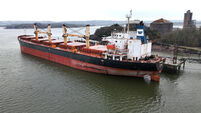New technology unveiled by machinery manufacturer Amazone will reduce the amount of fertiliser wasted on unproductive areas, such as field boundaries, without the hassle of leaving the cab.
The BorderTS deflector for the ZA-TS mounted spreader and the ZG-TS trailed spreader can be activated to prevent boundary spreading without stopping or slowing down.
It comes at a time when fertiliser prices have risen significantly, up to two and a half times in the last six months in Ireland, meaning the pressure will be on farmers and contractors to maximise the return from the fertiliser they invest in.
The limiter can be used if the first tramline is half the working width of the fertiliser spreader in from the edge of the field and can be used for side, boundary and watercourse spreading.
Crucially, the system does not require the operator to leave the cab or interrupt spreading.
It works through the use of an in-cab terminal which can also be used to reduce the spread rate.
The limiter can be moved around a fixed frame to give a generously dimensioned swivel range.
This sets the limiter to the required position for side, boundary or watercourse spreading, depending on the type of fertiliser, with a setting chart to help drivers select the correct programme.
When not in use, the limiter swivels up and out of the way on a hydraulic cylinder.
Wind compensation
Amazone has also developed technology that automatically adjusts spreading to the wind speed, calculating how pellets are likely to be carried by crosswind and adjusting the spreading distance and pattern accordingly to compensate.
It uses a high-frequency wind sensor, mounted on the fertiliser spreader, to record both the wind speed and the wind direction and transmits this information to the job computer. This processes the data with the forward speed and calculates new settings for both the delivery system and the spreading disc speed, which are then automatically adjusted.
In a crosswind, the disc speed is increased on the side into the wind and the delivery system is rotated outwards.
At the same time, the disc speed is decreased on the side facing away from the wind and the delivery system is turned inwards.
This automatically counteracts the wind effect and ensures an accurate distribution.
In addition, the manufacturer claims the use of ‘WindControl’ results in larger time windows for fertilisation.










